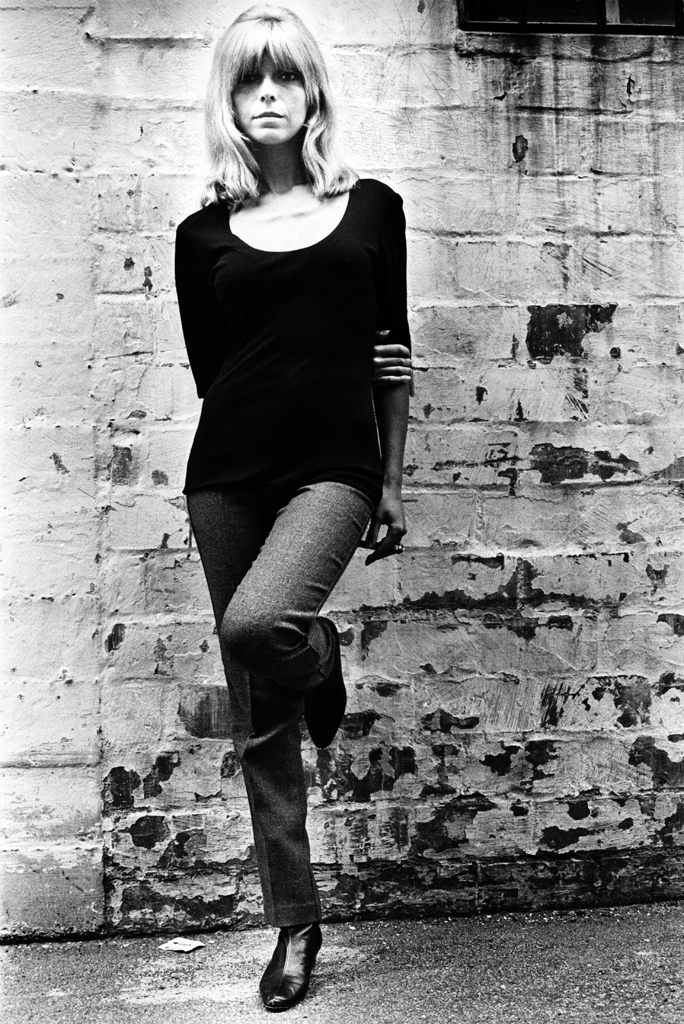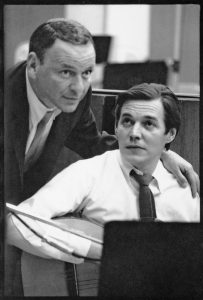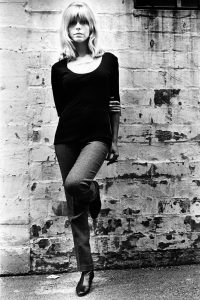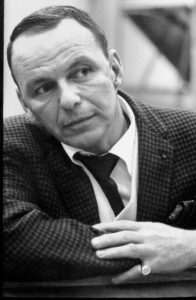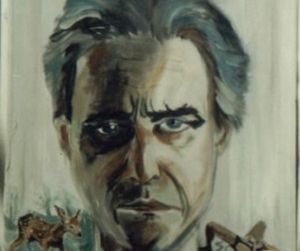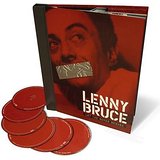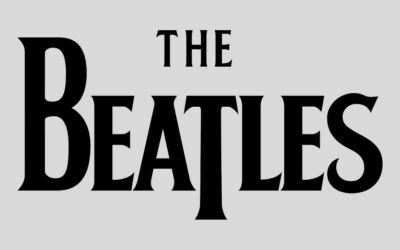CD & Digital Commemorative Edition Adds Two Bonus Tracks;
Remastered Album Also Available on 180-gram Vinyl LP & Exclusive, Limited Edition Blue Vinyl LP
By Harvey Robert Kubernik c 2017
Frank Sinatra’s acclaimed 1967 album with Brazilian music legend Antonio Carlos Jobim, Francis Albert Sinatra and Antonio Carlos Jobim is now
expanded for its 50th Anniversary Edition. In April it was released on compact disc and digital formats via Universal Music Enterprises.
A remastered original album was issued as well on heavyweight 180-gram vinyl LP and in a limited blue vinyl edition, available exclusively from the Sinatra Shop and UDiscover Music.
Francis Albert Sinatra & Antonio Carlos Jobim brought together two maestros from divergent musical worlds in a serene sigh of sun-dappled bossa-nova.
In evening studio sessions at Hollywood’s Western Recorders between January 30 and February 1, 1967, Sinatra breathed new life into the album’s 10 songs, accompanied vocally on four by Jobim, who also played guitar on the album.
The album’s tracks include seven Jobim originals and three American Songbook classics, delicately arranged and conducted by Claus Ogerman with a studio orchestra.
Ogerman’s studio credits were Wes Montgomery, Kai Winding, and Cal Tjader as a staff arranger for the Verve label on many Creed Taylor productions 1963-1967. He also arranged and conducted the Bill Evans Trio with Symphony Orchestra in 1966.
Earlier in the sixties, Ogerman arranged a number of pop hit singles, including Solomon Burke’s “Cry to Me,” and conducted the orchestra for Quincy Jones’ production of Leslie Gore’s “It’s My Party.”
Sonny Burke produced the heralded Sinatra and Jobim album.
Burke was a big band arranger who worked with Charlie Spivak and Jimmy Dorsey bands, later writing tunes with Peggy Lee for Disney’s Lady and the Tramp, and the song “Black Coffee,” with Paul Francis Webster.
He also served as bandleader for vocalists Bing Crosby, Dinah Shore, Ella Fitzgerald and Mel Torme, eventually becoming musical director of Reprise Records.
“I Concentrate on You” penned by Cole Porter for the 1940 movie Broadway Melody of 1940, was a popular turntable hit on L.A. radio station KMPC.
“I haven’t sung so soft since I had the laryngitis,” joked Sinatra during their first evening together in the studio, easing into the hushed swing of the sessions.
Immediately after Sinatra concluded his February 1st date with Jobim, Frank and his daughter Nancy, with session musicians later to be known as the Wrecking Crew, including drummer Hal Blaine and guitarist Al Casey, with producers Lee Hazelwood and Jimmy Bowen, and an arrangement from Billy Strange, cut the Carson Parks-penned single “Somethin’ Stupid.”
Their duet reached number one in the Billboard charts and appeared on the Frank Sinatra Reprise LP The World We Knew.
In her book Frank Sinatra: An American Legend, Nancy Sinatra wrote about recording “Somethin’ Stupid” with her father.
“At the end of the session, the A Team in the studio stepped aside, and Dad let me bring in my B Team to record a duet novelty song called ‘Somethin’ Stupid.’ On the first take, Dad got silly, sounding his S’s like Daffy Duck for fun, so we had to do a second take. Mo Ostin, the president of Reprise, bet him two dollars it would bomb. He lost his money. It went to number one, selling several million copies.”
Francis Albert Sinatra & Antonio Carlos Jobim ascended Billboard’s albums chart in April 1967, peaking at No.19 and remaining on the chart for 28 weeks.
“At Reprise, the label he started in 1960, Sinatra was able to collaborate with such musical giants as Count Basie, Duke Ellington and Antonio Carlos Jobim. The pairing of Sinatra and Jobim in 1967 is one of the best collaborations during Frank’s ‘Reprise’ era,” mentioned Charles Pignone, producer-archivist for the Sinatra Family, and author of The Sinatra Treasures.
“Sinatra’s singing is sublime. Jobim’s playing is perfection. Claus Ogerman’s arrangements are exquisite. The orchestra is outstanding. The album, to this day, is simply superb!”
I also really dug the television special Frank Sinatra: A Man and His Music + Ella + Jobim that was taped at NBC studios in Burbank and was broadcast in November of 1967.
Sinatra was a Grammy winner in 1966 and 1967 but in 1968 at the 10th Annual Grammy Awards his album with Jobim was nominated for Album of the Year but lost out to the Beatles’ Sgt. Pepper’s Lonely Hearts Club Band.
The 50th Anniversary Edition’s CD and digital configurations implement two bonus tracks: A medley of “Quiet Nights of Quiet Stars”/“Change Partners”/“I Concentrate on You”/“The Girl from Ipanema” from A Man And His Music + Ella + Jobim, and a previously unreleased studio session of “The Girl from Ipanema” from January 31, 1967.
“The 1967 Sinatra/Jobim album is beautiful, all 27 minutes of it, and I’m glad it’s being reissued for a wider audience,” offered KEBF-FM deejay, James Cushing, who hosts the program Jazz Classics in Morro Bay, California.
“The quiet that Jobim’s music contains rubs against Sinatra’s vivid bel-canto extraversion in a memorable way and it’s great to hear the two men singing together, as well. I’m OK with Claus Ogerman’s orchestrations, but honestly, a chamber jazz group of guitar-bass-piano would have done just as well if not better.”
The Sinatra and Jobim teaming, at Western Recorders on Sunset Blvd. was just a handful of months after a 1966 encounter Sinatra had with Rolling Stones’ manager and record producer Andrew Loog Oldham and Keith Richards, courtesy of Joe Smith of Warner/Reprise Records who extended an invitation to the duo who were finishing up their Aftermath album at nearby RCA Studios.
Frank was very cordial to Andrew and Keith in their two hour visit, and asked them if they knew his U.K. concert promoter, the talent agent and music impresario Harold Davidson, who also promoted the likes of Count Basie, Stan Kenton, Bing Crosby, Ella Fitzgerald, and helped launch the Dave Clark Five and the Rolling Stones in England.
“I’d always regarded Sam Cooke and Elvis Presley, and later Bob Dylan as the real self-producing artists of the era,” Andrew told me in a 2004 interview.
“Sinatra and Bing Crosby had to be the guv’ners – Keith Richards and I got to watch Mr. Sinatra record, that was an education in form and producing thyself. It’s an art that Julio Iglesias and Lionel Ritchie mastered in the 80’s – to know thyself and how to dress yourself in sound, song and polish every word so that it belongs. It places you above anything that can be deemed the A&R domain. You have that uncanny period of time where you are at one with the audience.
“I saw Sinatra live in Paris in 1976 when my wife Esther and I were living there,” Oldham reminisced in a 2017 lunch conversation. “First time I had seen a singer as instrument in the band. He mixed himself into the band and sang his way out of that mix.
“Frank Sinatra had more lives than David Bowie.
“The Sinatra/Jobim collaboration was a masterpiece in casting and execution. North and South America – Hoboken in the balmy tropics. A forever moment!”
Francis Albert Sinatra & Antonio Carlos Jobim (50th Anniversary Edition)
CD / Digital
| 1. The Girl from Ipanema | 6. If You Never Come to Me |
| 2. Dindi | 7. How Insensitive |
| 3. Change Partners | 8. I Concentrate on You |
| 4. Quiet Nights of Quiet Stars | 9. Baubles, Bangles and Beads |
| 5. Meditation | 10. Once I Loved |
BONUS TRACKS
11. Sinatra-Jobim Medley: Quiet Nights of Quiet Stars/Change Partners/I Concentrate on You/The Girl from Ipanema (from A Man And His Music + Ella + Jobim)
12. The Girl from Ipanema (previously unreleased studio session from January 31, 1967)
180g Vinyl LP / Limited Edition Blue Vinyl LP
| SIDE 1 | SIDE 2 |
| 1. The Girl from Ipanema | 1. If You Never Come to Me |
| 2. Dindi | 2. How Insensitive |
| 3. Change Partners | 3. I Concentrate on You |
| 4. Quiet Nights of Quiet Stars | 4. Baubles, Bangles and Beads |
| 5. Meditation | 5. Once I Loved |
“When a journalist went to interview pianist Keith Jarrett a few years back, he was struck by the presence of Sinatra’s Capitol Years box set occupying a place of pride in the jazz icon’s home office,” observed author and keyboardist, Kenneth Kubernik. “Jarrett’s trio had been featuring ‘I’m A Fool to Want You’ and ‘In the Wee Small Hours’ in their set.
“It’s easy to overlook the status Sinatra enjoyed among the jazz cognoscenti; his larger-than-life persona often drowned out the nuanced, instinctual command he brought to his interpretive art, the hallmark of a great musician with big ears.
“Saxophonist Wayne Shorter heard something too. Sharing the front line with Miles Davis in, arguably, the most vital jazz quintet of the sixties, Shorter wouldn’t let his ultra-hip street cred distract him from embracing Sinatra’s anodyne pop collaboration with bossa nova’s premier voice, Tom Jobim. ‘Dindi’ would soon find itself provocatively reborn on Shorter’s 1969 Blue Note album, Super Nova, the Brazilian rhythms of batucada and samba framing an emotionally wrought vocal reading far removed from the Chairman’s Scotch and water take.”
In the very early-fifties my parents saw Sinatra sing for his supper a number of times at small joints, restaurants and steak houses in Palm Springs when the entertainer was really down and out. It was a period when Frank’s contract was not renewed at Columbia Records. He had lost his voice, agent and career.
Then his remarkable artistic and commercial renaissance, with an assist from then-wife Ava Gardner, who helped persuade Columbia Pictures studio head Harry Cohen in 1952 to cast Sinatra for the low paying acting job over higher priced actor Eli Wallach in From Hell to Eternity. It won Sinatra a Best Supporting Oscar in 1953, after he inked a new and basic entry level recording contract from President Alan Livingston at Capitol Records.
As a youth in the early-sixties I went with my family a few times to see Frank perform in Las Vegas Nevada at the Sands Hotel and Casino. I was mostly locked up in their hotel room for the engagement but caught some of the action.
Comedian Buddy Hackett, his opening act, was funny and naughty.
I later sat with my mother Hilda in Television City at a CBS sound stage in West Hollywood and witnessed some Sinatra television specials where we had earlier watched 1963-1965 tapings of The Danny Kaye Show. Danny portrayed a character named Jerome. We also in the audience for The Judy Garland Show. Barbra Streisand and Judy Garland sang an amazing duet of “Happy Days Are Here Again.”
My mother and I caught Frank Sinatra again in 1978 at the Universal Ampitheater in Universal City when I was west coast director of A&R for MCA Records located on the Universal lot. We were seated with Liza Minelli. I told her Freddie Mercury of Queen really loved her act and saw her London Palladium engagement. I had just interviewed Freddie for Melody Maker. My mom in 1939 saw Liza’s mother Judy Garland in Chicago when she opened her show with “Zing! Went the Strings in My Heart.”
Author Richard Havers in his 2004 book Sinatra interviewed my mother about Frank and his musical and cultural impact in the forties.
“I lived in Chicago and was a big fan of Frank. I had seen him at WMAQ in Chicago when he did a radio show with Tommy Dorsey in 1940 and I was determined to go to New York and see him at the Paramount Theater in December of 1943. My cousin, who lived in Brooklyn, met me at the train station and we went straight to the Paramount. Frank was amazing: I was not a screamer. I just sat there paralyzed. We stayed and watched every performance until they threw us out at around 10:30 or 11:00. I left Sunday and back home to Chicago Monday morning. Looking back I think what was important was that he was there when we needed someone.”
In the early eighties, my parents were invited to a party at Chasen’s restaurant in West Hollywood arranged by Las Vegas hotel owner Steve Wynn for Golden Nugget Hotel stock holders. Frank and his wife Barbara were present and politely visited the booths and tables.
An excited Hilda Ria Kubernik finally met Francis Albert Sinatra. My mother told Frank she was at one of the 1943 Paramount Theater shows in New York, as a giddy girl who just graduated high school in Chicago. She enthusiastically posed for a photo with him, and Frank immediately turned to my father Marshall, and suggested to him, “I think your broad needs a drink.”
In 1960 Sinatra founded his own imprint, Reprise, with Warner Bros. Records.
In 1966, Frank was back on top of the pop and rock charts with “That’s Life,” courtesy of legendary music man Russ Regan who worked at Loma Records, a division of Reprise.
“I was general manager at Loma and I gave ‘That’s Life’ to Frank Sinatra to cut,” explained Regan to me in my 2014 book, Turn Up The Radio! Rock, Pop, and Roll in Los Angeles 1956-1972.
“Kelly Gordon, a songwriter, who co-wrote it, first gave the tune to me. He played a little piano. Kelly brought me the demo of ‘That’s Life,’ which had already been recorded. It was just a hit by O.C. Smith in Houston, Texas. Kelly wanted to record it, but I told him it was a Frank Sinatra hit. [He said,] ‘Be my guest.’
“So I went around my office—it was next door to Mo Ostin. ‘Mo, let me play you this song. I think it’s a hit for Frank Sinatra.’ Mo, God bless him, puts it on, and says, ‘Russ, this is a smash for Frank Sinatra.’ He [says to] his secretary and assistant, ‘Donna. Get me ABC Messenger Service.’
“He sent the dub over to Frank Sinatra. It went to his home after he called Frank. He had the direct line. Two days later, Mo Ostin calls me on the intercom. ‘You sitting down? Frank loves the song. He’s gonna do it.’ Frank was my idol.
Initially, Jimmy Bowen was going to produce it, but he got Ernie Freeman because he felt there was an R & B kind of feel.
“So we all went to United Western. Frank did it in two takes. Never met him, [but] I watch it go down with the vocal contractor B.J. Baker and her background singers. [Gwe Johnson and Jackie Ward]. I walked [out] onto Sunset Boulevard. ‘Thank you, God. This is a smash!’
“Jimmy Bowen acknowledged me. The record got released thirty days later. It took off like a rocket ship. By October ’66, it was a Top 4 record on the pop charts and number one on the R & B charts. That could only happen because it was done in L.A.
“Then Frank flew me and Mo to Las Vegas, where he was playing the Sands Hotel. Mo and I took his wife, Mia Farrow, to dinner at the Flamingo to see Trini Lopez. He was also on Reprise, and she was a Trini Lopez fan. Then we came to the midnight show of Frank at the Sands, and we’re sitting ringside. Right? And he belted out ‘That’s Life,’ and I thought I’d died and gone to heaven. Incredible show. It was his anthem before ‘My Way’ replaced it. That Sonny Burke produced.
“After the show, we were all invited to have a 2:00 am supper at the Chinese restaurant at the Sands Hotel. Sinatra is sitting next to me. I’m calling him ‘Mr. Sinatra.’ He asks, ‘Can I call you Russ?’ ‘Sure!’ Everyone at the table knew I found the song.
“Mo and I flew back home at 10:00 am the next day. Two weeks go by after this incredible night, and I walk into Martoni’s Italian restaurant on Cahuenga to hang out with the record company guys. And there is Frank Sinatra, sitting there with Jilly Rizzo and his guys at a booth. I walk up to him [and say,] ‘Hi, Mr. Sinatra.’ [He says,] ‘Get lost, kid!’ So I start walking way—my heart was broken. [Then I hear,] ‘Get back here, Russ! I know who you are.’ Frank Sinatra got me good.”
David Kessel, the owner of www.cavehollywood.com also provides some unique anecdotes and historical reflections into the relationship his father and step mother had with Sinatra, Jobim and the world of Bossa Nova.
“My dad, jazz guitarist and producer Barney Kessel had his first recording studio encounter with Frank Sinatra in 1949. He was in the band that cut three tunes in Hollywood on September 15 of that year. This included ‘That Lucky Old Sun,’ ‘Mad About You’ and ‘Stromboli.’
“In the early 1960’s when Sinatra started his Reprise record label, my father was signed to the label. He did three albums, Breakfast at Tiffany’s, Bossa Nova, and Contemporary Latin Rhythms. All three albums had a Bossa Nova/ Cha Cha groove with a surf guitar vibe and cool cheesy organ and horn arrangements. He also released three singles and an EP. A total left field single was ‘Diamonds’ backed with ‘T.V. Commercials.’ Frank and company were well aware of the growing trend of the Latin infusion in pop music and the changing musical culture that was influencing young Americans and hipsters.
“It comes as no surprise to me that Sinatra, after having great success with ‘Strangers In The Night’ and ‘That’s Life’ in 1966, would follow up with an ‘Adult Contemporary Jazzy Pop’ collection and collaboration with Antonio Carlos Jobim in 1967. The Brazilian influence gave Sinatra an elegant outlet for a modern interpretation, showcasing his great voice, while achieving continued modern pop success. Jobim was one of the most influential Latin music practitioners of his time.
“The Latin music trend in America started in the late 50’s and into the 60’s. You don’t normally think about it, but in 1960 Brian Hyland’s ‘Itsy Bitsy Teenie Weenie Yellow Polka Dot Bikini’ smash hit was a Cha Cha. In 1962 ‘Sherry,’ a big hit by the Four Seasons was also a Cha Cha. In 1963 Eydie Gorme had a giant hit ‘Blame It on the Bossa Nova.’ All three songs helped make the Latin trend main stream and a part of our musical fabric. The kicker here is the release of Jobim’s composition ‘Girl from Ipanema’ in 1964 as a single by Astrud Gilberto and Stan Getz. It won a Grammy for best record of the year in 1965. This firmly established the Latin genre as a popular format.
“In 1966 the Anita Kerr Singers, coming off a Grammy for best vocal group of the year for the We Dig Mancini album, released the Slightly Baroque album, which contains two Jobim songs, ‘One Note Samba’ and ‘How Insensitive.’ As my step mother was in the group (vocal contractor and background singer B.J Baker). I listened to that album a lot and appreciated the influence Jobim had on all kinds of music.
“Sinatra and Jobim put the cherry on top of the ice cream with the Francis Albert Sinatra and Antonio Carlos Jobim album. A very classy outing, especially considering the release of the album came three months before the start of ‘The Summer Of Love’ in 1967.
“My Dad always played a Jobim song in his live Jazz set. His favorite stage line to get a laugh was ‘I’m going to play a lovely piece by Antonio Carlos Jobim. I know a lot you know his brother Jim Beam.’
“I met Frank Sinatra in the late 1960’s at Jilly’s in Palm Springs when I was a teenager. He was the consummate gentleman. I was with my dad, stepmom B.J. Baker (who both worked with Sinatra on many occasions) and my brother. We sat at a table right next to Frank. He got up and said ‘Barney, Betty, boys, hope you enjoy your meal’ and then came over to us and talked for a few minutes. I was really impressed at what a warm, caring, professional guy he was.”
Terry O’Neill is one of the world’s most accomplished and collected photographers whose work hangs in national galleries and private collections worldwide.
For more than 50 years his camera has chronicled the frontline of fame, in particular the emerging rock stars and icons of the 60s. O’Neill photographed the Beatles and the Rolling Stones when they were still struggling young bands seeking a recording contract in London’s clubs and pubs.
O’Neill worked closely too with Frank Sinatra over 30 years, being granted access to the chairman back stage and in private.
In 2012 I interviewed O’Neill for Treats! magazine after he published Sinatra: Frank & Friendly (Evans Mitchell Books).
HK: You photographed Frank Sinatra over the decades.
TO: When I first met Frank he was making a film Tony Rome. And I knew Ava Gardner very well. And told her, ‘I’ve got the chance to go across and photograph your ex-husband.’ And she said, ‘Oh, I’ll write you a letter.’
“Now I don’t know what she ever put in the letter of introduction, but I walked on the set of this film, handed him the letter, and he said. ‘Right, Bloke, you’re with me.’ Frank was always in love with Ava. Always.
“Ava opened the door to me and I never looked back. I covered his concerts, rehearsals and films. Frank never queried anything I did. I could walk in whenever I liked and take photos of whatever I liked. And then I was for the next 30 years off and on. I mean, I could go anywhere with him. Funny enough, in the beginning, I did not realize quite how big he was. Do you know what I mean? I did not realize the sort of size of him and the impact that he has on the world. I loved his singing but I did not realize how great he was.
“Frank just had everything. I mean, you knew you were definitely in the presence of a great man. Irrelevant of what anyone ever says about him. He really was a great man and had a magnetic personality. Frank had this air about him; he really did light up a room when he walked in. When doing photos with him he was so comfortable he totally ignored me. It’s great because he just makes like you’re not there. And I went anywhere with him. He actually was a good photographer himself. He was an incredible man and he knew, you know, just to ignore you, so you could feel more comfortable and you could work better with him. You didn’t feel you were being intrusive.
“I had access with Frank, and I worked very hard. I didn’t sit around and talk with him all the time. I learned and realized with Sinatra as our working relationship went on that I can’t be one of the people sitting down having a drink with him. Because that is not what I want to be. I want to be the photographer. I think that he, during that period, wondered why I wouldn’t sort of be more friendly and sort of still have all the respect for him. Because I think respect is the key thing in my work. And it shows in the way I look at people in my photographs
“When I assembled the Frank book, first of all it brought back lots of memories seeing all the pictures. It was just my tribute to him. Because I’ve always wanted to give something back to him. And that was my way of doing it. I promised him I’d do this book one day and I never really got around to it. I did get everything all together now and sort of repaid him by doing the book.
HK: Your book shows us the process, knowledge, and empathy Sinatra had for his audience and the understanding of the songbook on record and in performance.
TO: Frank’s love for the music and the musical history was always very apparent to me. He cited the musicians. When he walked out on stage he just had a presence and he just hypnotized the whole audience. I mean, I never saw him not give 100 per cent. And he cared a lot about the music. He was brilliant at rehearsals. You think he walked out there and ‘Ring-A-Ding-Ding’ and just does it. But he listens to the audience when the comedian is on, the warm up guy, and he gages the mood of the audience, and he was a great conductor as well. He was a very versatile guy.
“Yes, unlike the Beatles later, and the Stones, he didn’t write the songs he sang but it was like the songs were written for him. But he was a wonderful man and always gave absolute full credit to every songwriter, always. And arrangers.
Throughout his six-decade career, Frank Sinatra performed on more than 1,400 recordings and was awarded 31 gold, nine platinum, three double platinum, and one triple platinum album by the Recording Industry Association of America. Sinatra demonstrated a remarkable ability to appeal to every generation and continues to do so; his artistry still influences many of today’s music superstars. The Oscar® winner also appeared in more than 60 films and produced eight motion pictures.
Sinatra was awarded Lifetime Achievement Awards from The Recording Academy, The Screen Actors Guild and the National Association for the Advancement of Colored People (NAACP), as well as the Kennedy Center Honors, the Presidential Medal of Freedom and the Congressional Gold Medal.
For more information about Frank Sinatra, visit sinatra.com.
David Kessel’s good buddy John Pizzarelli (son of the great Jazz guitarist Bucky Pizzarelli) has a new álbum coming out July 28 2017,“Sinatra and Jobim@50” in comemeration of this historic pairing. Daniel Jobim, the grandson of Jobim, joins John on this inspired tribute.
(Harvey Kubernik has been a music journalist for over 44 years and is the author of 10 books, including Leonard Cohen, Everybody Knows, and Neil Young, Heart of Gold. In April 2017, Sterling published Kubernik’s 1967 A Complete Rock Music History of the Summer of Love).

